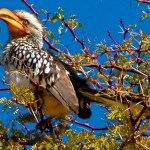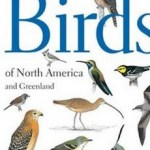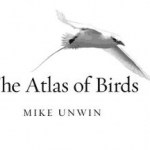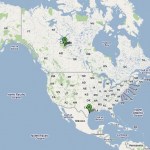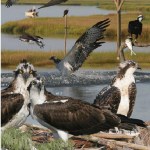Aves (birds)
All of my Bird Book Reviews are Here, and some of the reviews include broader discussions that go beyond the book, so do browse through them.
Feeding Birds:
Should you even be feeding the birds to begin with?
Birders get annoyed at squirrels for obvious reasons. But you can be happier about the squirrels in your yard if you just change your attitude and see the gray squirrels as food!
Watching Birds
What makes for a good bird?
The falcon eats tonight ...
The Science of Birdwatching
Let the Eagle Soar
We Walk Among Ducks In Wolves Clothing. And Wolves.
Ducks Blowing In The Wind
When is a…
What kind of birding binoculars do you use? How do you chose a good model?
Obviously, the best way to pick out a pair of binoculars is to try them out, but in doing so, I strongly urge you to try at least a couple of pairs that are beyond your budget, and work your way down from there. Not knowing what an excellent pair of binoculars is like makes it difficult to judge among the lesser forms that you will ultimately have to pick from. Putting it another way, if all you know is the $50 special, and you use a pair of them for a season or two, then the first time you bring a nice pair up to…
Face it. Half the time ... most of the time, really ... you use your Peterson (or some other favorite "field guide") as a checklist. You see a bird and you pretty much know in your head what it is, but you need to look it up to see what the three or four similar ducks or woodpeckers or whatever are in your area in order to be sure that it is a Common Merganser or a Red Headed Woodpecker or whatever. All you need is a basic picture (drawing preferred for this sort of thing) the names of the birds and basic range maps.
That is the role played by the Princeton Illustrated Checklists; These…
How are birds related to dinosaurs, crocodiles, and pterosaurs? Where do birds live, and not live? How many bird species are there, and how many actual birds, and how does this vary across the glob? What about endemics?; Where ate the most local species found? Mike Unwin's The Atlas of Birds: Diversity, Behavior, and Conservation covers this and more in a richly illustrated detailed global survey of Aves.
This new and very impressive, and highly accessible volume covers bird biogeography with an overview of counts and diversity followed by a continent-by-continent review, to give you an idea…
Birds don't live in nests. They make nests for specific purposes, use them for that purpose, then abandon them. Or, sometimes they don't abandon them, but rather add on and use them again and again, but in between they don't live in or on them. Well, sometimes they hang out on them a lot. And not all nests are for putting their eggs in. In fact, sometimes a nest is more of a symbol of quality and overall bird sexiness than it is a place to keep the chicks. As it were. Oh, and sometimes they live in the nests, now that I think about it ... It's complicated.
But there is a book that…
Here in the Northern Hemisphere, many of our birds fly away in the fall. Other, very cool birds from even farther north, depending on where you live then arrive. But just about now, where I live, we are at the tail end of the migration out and not quite at the migration in, so this is a good time to take stock of what is important: Which bird books do you want people to give you for Christmas?
Before I make any suggestions, I would like to point out that Princeton, an emerging and major player in the Bird Book world, has a facebook page that, if you "like," will automatically enter you in a…
Rapid climate change can cause species extinction. But if a species is highly mobile or wide-ranging, then that effect may be attenuated. And, more rapid climate change would be more serious a problem than less rapid climate change. Therefore, there should be a relationship between species mobility (migration) and the rate, or velocity, of climate change vis-a-vis extinction. This is a nice set of hypotheses which have been tested in a recent paper. The abstract:
The effects of climate change on biodiversity should depend in part on climate displacement rate (climate-change velocity) and…
ÐовÑÐ´Ð¾Ð¼Ð»ÐµÐ½Ð½Ñ Ñ Ð±Ð»Ð¾Ð·Ñ Ñ Ð½Ð°Ð¿Ð¸Ñав Ð´Ð»Ñ 10 ÑиÑÑÑ Ð¿ÑаÑÑв, з пиÑÐ°Ð½Ñ Ð¼ÑгÑаÑÑÑ, бÑв пеÑеведений беÑÐµÐ·Ð½Ñ Ruszkowski на ÑкÑаÑнÑÑкий Langauge, Ñ Ð´Ð¾ÑÑÑпний Ð´Ð»Ñ ÐаÑ, Ñоб пÑоÑиÑаÑи ÑÑÑ: ÐиÑÐ°Ð½Ð½Ñ Ð¿Ñо мÑгÑаÑÑÑ
Я ÑподÑваÑÑÑ, Ñо ви лÑбиÑе ÑиÑаÑи його ÑÑÑлÑки, ÑкÑлÑки Ñ ÑподобалоÑÑ Ð¿Ð¸ÑаÑи його! Я не знаÑ, ÑкÑлÑки Ð·Ð°Ð´Ð¾Ð²Ð¾Ð»ÐµÐ½Ð½Ñ Ð¿ÐµÑÐµÐºÐ»Ð°Ð´Ñ Ñе бÑло, однаÑе! ÐÑкÑÑмо ÐеÑезнÑ.
People who watch birds identify them, and that process is integral to what makes birding interesting. But the best practices for identifying birds appear on the face of it to conflict with evolutionary concepts of birds, and this can lead to both sloppy thinking and missed opportunities
People who watch birds identify them, and that process is integral to what makes birding interesting. But the best practices for identifying birds appear on the face of it to conflict with evolutionary concepts of birds, and this can lead to both sloppy thinking and missed opportunities.
You need to know…
I've recently reviewed bird or nature books for some fairly exotic places (see this for all the reviews) including the Antarctic and the West Indies. Now, I have a book on the birds of one of the most exotic places ever: New Jersey!
OK, if you are from New York like I am, you know that was a joke. In all seriousness, New Jersey is an excellent place to go to see wildlife and I'm not talking about Atlantic City.
New Jersey has some of the largest swamps and marshes around, an extensive shoreline, and extensive pine barrens. Why, there are even mountains. The state, small and flattish…
I'm sitting here looking at Antarctic Wildlife: A Visitor's Guide. I've never been to the Antarctic so I can't tell you what I think of this book from the pragmatic angle of how well it works as a guide, but I can tell you that I've learned a number of things just looking at the book. For one thing, I had no idea that almost all tourist visits to Antarctica go to the same general area of the continent. I guess that makes sense given the geography of the region, but it had not occurred to me before.
I've guided a number of tours in Africa and some of my clients were very serious world…
The West Indies includes the Lucayan Archipelago (Bahamas and Turks and Caicos Islands); the Greater Antilles (Cuba, Hispaniola [Dominican Republic and Haiti], Jamaica, Cayman Islands); the Lesser Antilles (Leeward Islands [the Virgin Islands of Saint Croix, Saint Thomas, Saint John, Water Island, Tortola, Virgin Gorda, Anegada, Jost Van Dyke], Anguilla, Antigua and Barbuda, Antigua, Barbuda, Redonda, Saint Martin, Saba, Saint Eustatius, Saint Barthélemy, Saint Kitts and Nevis, Montserrat Guadeloupe); the Windward Islands (Dominica, Martinique, Saint Lucia, Saint Vincent and the Grenadines…
They used to hunt whooping cranes. Between that and habitat loss, the number dropped from nearly 20,0000 to a mere 1,400 during the first half of the 19th century, and continued to drop to an all time low of 15 birds in 1941.
Fifteen birds, in 1941, represented the entire species.
All those birds were members of a single flock that migrated between the Aransas National Wildlife Refuge in Texas, USA and Wood Buffalo National Park in Canada.
Most people know the story, or at least, the vague outlines of the story. Much has been written about them, including several books such as Cranes:…
These are the kinds of books you get if you are either a scientists studying bird migration and related issues, or a very serious bird geek. The first two can be obtained at very low prices used, but the third will set you back at least 50 bucks US$ if you want a used copy. Note the spread of publication dates. It is not the case that the oldest book is out of date in all respects: Quite the contrary. Alerstam reviews theory and ideas that have not been revisited or revised to any great degree. Also, it is interesting to see how changes in the field develop over a decade or so. In any…
This post at 10,000 Birds, an item I accidentally bumped into on the Internet while looking for something else, and an unusual sighting moments ago, converge. And, its a nice distracting convergence which I need right now because as I sit here one week before fishing opener, looking at the glassy surface of Hunters Bay, I see fish jumping everywhere. Not only that, but a 54 inch muskie was found dead a few days ago 25 feet from where I'm sitting now. And, the Department of Natural Resources put up a fish weir just across the bay, and they've been coming by every morning and pulling out…
Description and identification of birds, or anything else, can be done in a rote manner with straightforward reference to details. If information about enough details is available, the identification will be accurate. But as humans we hardly ever do that sort of thing. If you ask someone to describe a car they saw recently, they will not refer to the angle of the back end or the overall dimensions or the specific layout of the headlights and tail lights. A person who does not know the make and model may say something like "It's a hatch back" or "It's an SUV" and in so doing provide…
Imma let you hear all about how Hawks at a Distance: Identification of Migrant Raptors is a remarkable and important field guide, but first I want to mention that one of the most interesting parts of that guide is the forward by Pete Dunne, who himself has written a bird book or two. Dunne reviews the history of bird identification guides, going back to the time before they actually included illustrations (yup, just words!) and follows the evolution of bird guides through the 20th century, with special reference to how raptors have been handled. Or, more exactly, mishandled.
It make sense…
Three days ago I happen to glance out the front window of our townhouse and found myself staring at a bald eagle swooping by, presumably after picking up one of the neighborhood dogs or small children1 A few minutes later, the doorbell rang. When I opened the door, no one was there but a package was on the stoep. And in the package was my new The Crossley ID Guide: Eastern Birds! It was almost a Harry Potter moment.
The Crossley ID Guide is a unique and special bird book. It is not exactly a pocket field guide, unless you are the Jolly Green Giant and have pockets the size of ... well,…
Over the last few days, there have been several reports of mass die-offs of birds, and one report of a fish die-off. These events have been linked, via suggestion but not evidence, to hail, lightning, fireworks, aircraft, aliens, each other, poison gases, and even pockets of oxygen free air. Many have suggested that there may be a cover up. What is the explanation for so many highly unlikely events happening in such a short time period?
The answer may astound you:
Nothing.
According to available records, close to a hundred mass die-offs of birds occur each year in the US. The recent…
In the renowned yet obscure documentary, "Dead Birds," watchful men in a traditional community in Highland Papua New Guinea use the sudden flight of birds as a clue to the possible encroachment of a hidden enemy bent on blood revenge. In mines, canaries signal air too poisoned to breath by dying faster than affected humans. And in Arkansas, apparently, the sudden death of thousands of blackbirds are used to indicate the nefarious activities of aliens from another planet.
These unexplained (or actually, over explained) instances of blackbird death, one a few days ago in Arkansas and one…
